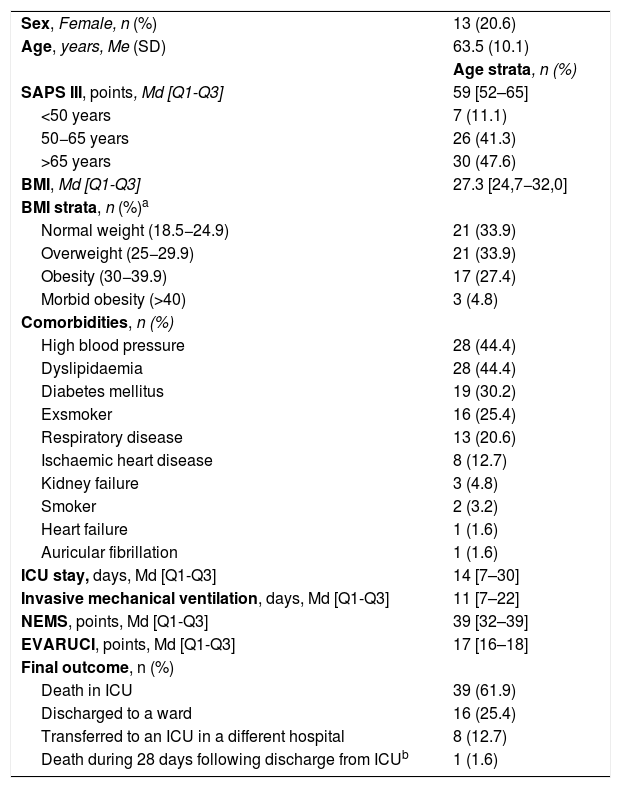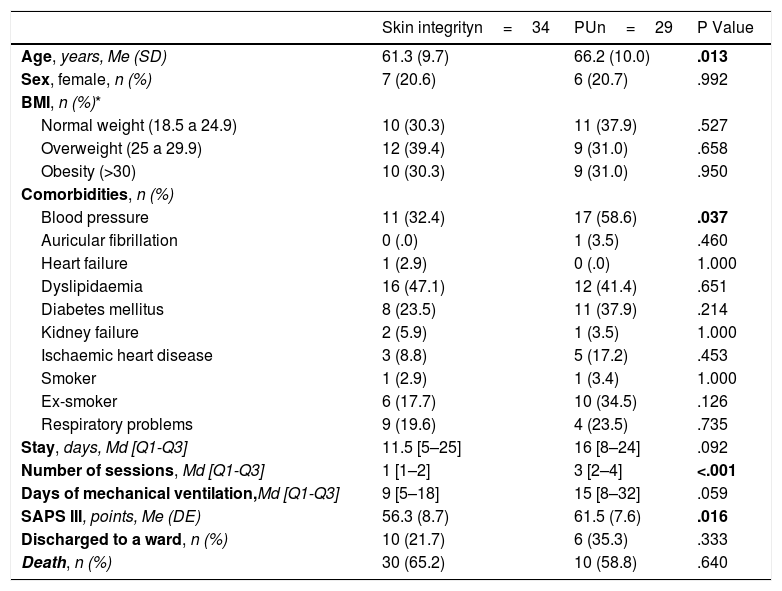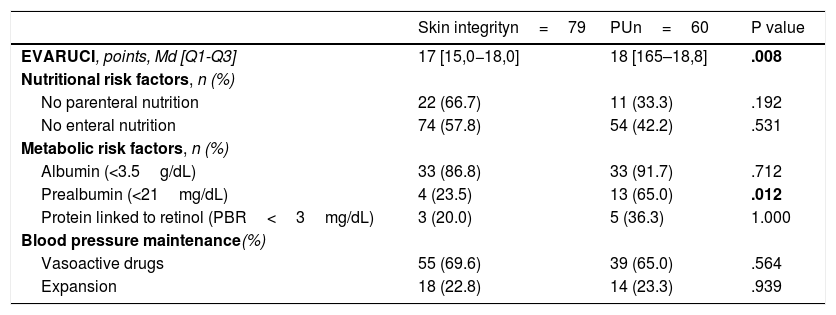To identify adverse events related to prone positioning in COVID-19 patients with severe disease and acute respiratory distress syndrome, to analyze the risk factors associated with the development of anterior pressure ulcers, to determine whether the recommendation of prone positioning is associated with improved clinical outcomes.
MethodsRetrospective study performed in 63 consecutive patients with COVID-19 pneumonia admitted to intensive care unit on invasive mechanical ventilation and treated with prone positioning between March and April 2020. Association between prone-related pressure ulcers and selected variables was explored by the means of logistic regression.
ResultsA total of 139 proning cycles were performed. The mean number of cycles were 2 [1–3] and the mean duration per cycle was of 22h [15–24]. The prevalence of adverse events this population was 84.9 %, being the physiologic ones (i.e., hypo/hypertension) the most prevalent. 29 out of 63 patients (46%) developed prone-related pressure ulcers. The risk factors for prone-related pressure ulcers were older age, hypertension, levels of pre-albumin <21mg/dl, the number of proning cycles and severe disease. We observed a significant increase in the PaO2/FiO2 at different time points during the prone positioning, and a significant decrease after it.
ConclusionsThere is a high incidence of adverse events due to PD, with the physiological type being the most frequent. The identification of the main risk factors for the development of prone-related pressure ulcers will help to prevent the occurrence of these lesions during the prone positioning. Prone positioning offered an improvement in the oxygenation in these patients.
Identificar eventos adversos secundarios al decúbito prono (DP) en pacientes con COVID-19 con síndrome de distrés respiratorio agudo (SDRA) moderado/severo, analizar los factores de riesgo para el desarrollo de úlceras por presión (UPP) en DP y describir la evolución oximétrica de estos pacientes durante el DP.
MétodoEstudio descriptivo retrospectivo realizado sobre 63 pacientes ingresados en la UCI de un hospital de segundo nivel, con neumonía por SARS-CoV-2, SDRA moderado/severo, ventilación mecánica invasiva, que precisaron maniobras de DP, durante marzo y abril de 2020. Se usó un muestreo no probabilístico consecutivo y se analizaron las variables seleccionadas a través de una regresión logística.
ResultadosSe realizaron un total de 139 sesiones de pronación. La mediana de sesiones fue de 2 [1–3] y la duración de 22horas [15–24] por sesión. La aparición de eventos adversos ocurrió en un 84,9% de los casos, siendo las fisiológicas (ej. hiper/hipotensión) las más frecuentes. Al comparar pacientes pronados que mantuvieron la integridad cutánea (34 de 63 pacientes, un 54%) versus los que desarrollaron UPP (29 de 63, un 46%), estos últimos presentaron los siguientes factores de riesgo: mayor edad, ser hipertensos, pre-albúmina <21mg/dl, mayor número de sesiones de prono y mayor gravedad al ingreso. Se observó un incremento significativo entre la PaO2/FiO2 previa al DP y en los diferentes cortes temporales durante el prono, además de una caída significativa tras despronar.
ConclusionesExiste una alta incidencia de eventos adversos debidos al DP, siendo los de tipo fisiológico los más frecuentes. La identificación de varios factores de riesgo para el desarrollo de UPP ayudará a prevenir la aparición de estas lesiones durante la pronación. La terapia de DP en pacientes COVID-19 con SDRA moderado/severo ha demostrado una mejora en los parámetros de oxigenación.













